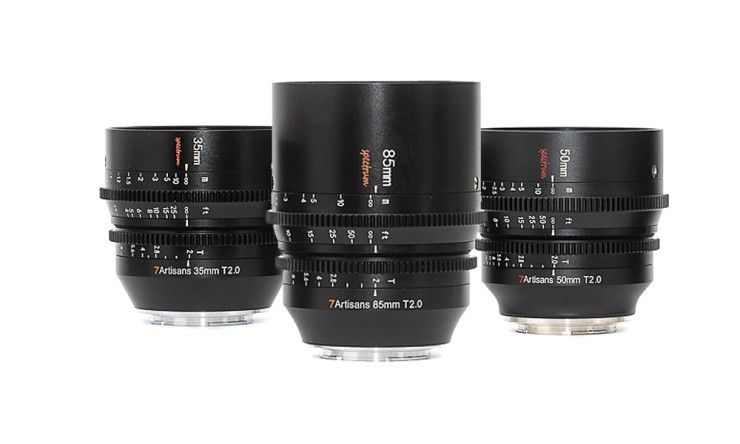
Budget cinema lenses are a growing market. But how do quality and affordability coexist? 7Artisans might have the answer.
Dedicated cinema lenses have always been a pricey purchase. While they would last multiple generations of camera bodies, most creatives would still only be able to rent them. Then the price point started to fall as more and more affordable options hit the market. Now one lens maker, 7Artisans, is making its move into the cinema camera space.
This year, the company released two lines of low-cost cinema lenses, which have price tags of under $675 per lens. The 7Artisans Vision series covers APS-C/Super 35, while the 7Artisans Spectrum line is all about full frame.

A New Player Has Joined
Both lines of lenses were introduced this year by 7Artisans and contain a robust set of focal lengths.
In the full-frame Spectrum line, 7Artisans has a 35mm T/2.0, a 50mm T2.0, and an 85mm T2.0. Meanwhile, the Super35mm/APS-C Vision line offers a 25mm T/1.05 APS-C Lens, a 35mm T/1.05 APS-C, and a 50mm T/1.05 “nifty fifty.” This has now been extended with the new 12mm T2.9 Prime.
One quick glance and these budget cine lenses sure look the part, but are they robust enough to handle the professional-grade workflow? Digging into the design, the lenses are made with a claimed near-zero breathing, which enables image stabilization during focusing. The large aperture image circle creates a soft bokeh and a vivid image that isn’t hard in its presentation. There’s also a uniform color balance while shifting from lens to lens thanks to a consistent lens element and coating process. Some budget cine lenses struggle with this, so it's nice to see a focus on the set instead of individual lenses.
These lenses are ideal for shooters looking to add cinematic production value with their existing camera rigs, while not altogether ready to take the next step to a more expensive cinema camera like the RED V-Raptor, the Sony FX30, or Sony VENICE. Shooters can upgrade their images and workflow while remaining within their indie budget.

Each lens in both lines has focus and iris gears in the same relative position, making it easy to swap lenses without spending time readjusting the position of your follow focus unit or iris motor. Likewise, the lenses all have the same filter size, making changing matte boxes and filters fast and easy without needing additional step-up rings or adapters. From a workflow standpoint, they tick all the boxes that we've come to expect from cine glass.
The New Addition
The latest in the Vision APS-C line is the 12mm T2.9 Cine Prime. It isn’t as fast as similar lenses in the Vision line, but it does have a very close-up focus range of 0.46 feet (0.14m). The lens has 12 lens elements organized into 10 groups, with a 9-blade aperture for smooth bokeh. It is also designed to incorporate the industry standard 0.8 MOD gears with a long focus throw of 270° and a de-clicked aperture ring. All in all, it matches the foundation set by the previous lenses in the Vision line.

The Vision line is available piecemeal, with the 25mm T1.05 APS-C lens for $549, the 35mm T1.05 APS-C lens for $499, and the 50mm T1.05 for $430.
It also looks like users can pick up two- and three-lens sets for $1,478 and $1,528 for the Vision line, with the Vision 12mm being sold separately for $319. Another nice touch is the number of mounts supported. This includes the Sony E-Mount, Nikon Z mount, Canon RF Mount, L-Mount for Leica, Panasonic, and SIGMA, as well as CL/TL fittings. There is also support for M43-mounted cameras such as the Blackmagic Pocket Cinema Camera 4K.
If looking at the full-frame Spectrum line, the 35mm T2.0 lens is $419, the 50mm T2.0 lens is $379, and the 85mm T2.0 is $459. The three-lens set is $1,257. Several mounts are also supported including the Sony E-Mount, Nikon Z mount, and the L-Mount for Leica, Panasonic, and SIGMA.

Is This the Budget Lens for You?
While they aren't the cheapest cine lenses on the market, both the Vision and Spectrum get damn close. 7Artisans is also leaning heavily on its photo lens pedigree, which has seen some amazing little lenses come out. However, how they perform will always end up being something the creative decides for themselves.
Whether these lenses are for you or not, this is definitely a much-needed addition to the market as it continues to democratize content creation to just about any production budget.
Do you plan on picking up a set? Let us know why or why not in the comments!
Your Comment